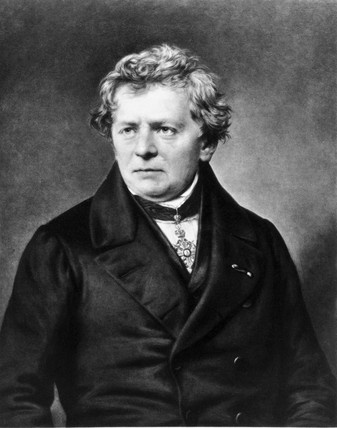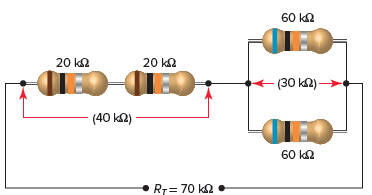Resitor Ohm's Law
Ohm's law states that the current through a conductor between two points is directly proportional to the voltage across the two points. Introducing the constant of proportionality, the resistance,[1] one arrives at the usual mathematical equation that describes this relationship:
where I is the current through the conductor, V is the voltage measured across the conductor and R is the resistance of the conductor. More specifically, Ohm's law states that the R in this relation is constant, independent of the current.[3] If the resistance is not constant, the previous equation cannot be called Ohm's law, but it can still be used as a definition of static/DC resistance.[4] Ohm's law is an empirical relation which accurately describes the conductivity of the vast majority of electrically conductive materials over many orders of magnitude of current. However some materials do not obey Ohm's law; these are called non-ohmic.
The law was named after the German physicist Georg Ohm, who, in a treatise published in 1827, described measurements of applied voltage and current through simple electrical circuits containing various lengths of wire. Ohm explained his experimental results by a slightly more complex equation than the modern form above (see § History below).
In physics, the term Ohm's law is also used to refer to various generalizations of the law; for example the vector form of the law used in electromagnetics and material science:
where J is the current density at a given location in a resistive material, E is the electric field at that location, and σ (sigma) is a material-dependent parameter called the conductivity. This reformulation of Ohm's law is due to Gustav Kirchhoff.
History
In January 1781, before Georg Ohm's work, Henry Cavendish experimented with Leyden jars and glass tubes of varying diameter and length filled with salt solution. He measured the current by noting how strong a shock he felt as he completed the circuit with his body. Cavendish wrote that the "velocity" (current) varied directly as the "degree of electrification" (voltage). He did not communicate his results to other scientists at the time,[6] and his results were unknown until Maxwell published them in 1879.

Francis Ronalds delineated "intensity" (voltage) and "quantity" (current) for the dry pile"a high voltage source"in 1814 using a gold-leaf electrometer. He found for a dry pile that the relationship between the two parameters was not proportional under certain meteorological conditions.
Ohm did his work on resistance in the years 1825 and 1826, and published his results in 1827 as the book Die galvanische Kette, mathematisch bearbeitet ("The galvanic circuit investigated mathematically").[10] He drew considerable inspiration from Fourier's work on heat conduction in the theoretical explanation of his work. For experiments, he initially used voltaic piles, but later used a thermocouple as this provided a more stable voltage source in terms of internal resistance and constant voltage. He used a galvanometer to measure current, and knew that the voltage between the thermocouple terminals was proportional to the junction temperature. He then added test wires of varying length, diameter, and material to complete the circuit. He found that his data could be modeled through the equation.
where x was the reading from the galvanometer, l was the length of the test conductor, a depended on the thermocouple junction temperature, and b was a constant of the entire setup. From this, Ohm determined his law of proportionality and published his results.
In modern notation we would write,
where is the open-circuit emf of the thermocouple, is the internal resistance of the thermocouple and is the resistance of the test wire. In terms of the length of the wire this becomes,
where is the resistance of the test wire per unit length. Thus, Ohm's coefficients are,
Ohm's law was probably the most important of the early quantitative descriptions of the physics of electricity. We consider it almost obvious today. When Ohm first published his work, this was not the case; critics reacted to his treatment of the subject with hostility. They called his work a "web of naked fancies" and the Minister of Education proclaimed that "a professor who preached such heresies was unworthy to teach science."The prevailing scientific philosophy in Germany at the time asserted that experiments need not be performed to develop an understanding of nature because nature is so well ordered, and that scientific truths may be deduced through reasoning alone. Also, Ohm's brother Martin, a mathematician, was battling the German educational system. These factors hindered the acceptance of Ohm's work, and his work did not become widely accepted until the 1840s. However, Ohm received recognition for his contributions to science well before he died.
In the 1850s, Ohm's law was widely known and considered proved. Alternatives such as "Barlow's law", were discredited, in terms of real applications to telegraph system design, as discussed by Samuel F. B. Morse in 1855.
The electron was discovered in 1897 by J. J. Thomson, and it was quickly realized that it is the particle (charge carrier) that carries electric currents in electric circuits. In 1900 the first (classical) model of electrical conduction, the Drude model, was proposed by Paul Drude, which finally gave a scientific explanation for Ohm's law. In this model, a solid conductor consists of a stationary lattice of atoms (ions), with conduction electrons moving randomly in it. A voltage across a conductor causes an electric field, which accelerates the electrons in the direction of the electric field, causing a drift of electrons which is the electric current. However the electrons collide with atoms which causes them to scatter and randomizes their motion, thus converting kinetic energy to heat (thermal energy). Using statistical distributions, it can be shown that the average drift velocity of the electrons, and thus the current, is proportional to the electric field, and thus the voltage, over a wide range of voltages.
The development of quantum mechanics in the 1920s modified this picture somewhat, but in modern theories the average drift velocity of electrons can still be shown to be proportional to the electric field, thus deriving Ohm's law. In 1927 Arnold Sommerfeld applied the quantum Fermi-Dirac distribution of electron energies to the Drude model, resulting in the free electron model. A year later, Felix Bloch showed that electrons move in waves (Bloch electrons) through a solid crystal lattice, so scattering off the lattice atoms as postulated in the Drude model is not a major process; the electrons scatter off impurity atoms and defects in the material. The final successor, the modern quantum band theory of solids, showed that the electrons in a solid cannot take on any energy as assumed in the Drude model but are restricted to energy bands, with gaps between them of energies that electrons are forbidden to have. The size of the band gap is a characteristic of a particular substance which has a great deal to do with its electrical resistivity, explaining why some substances are electrical conductors, some semiconductors, and some insulators.
While the old term for electrical conductance, the mho (the inverse of the resistance unit ohm), is still used, a new name, the siemens, was adopted in 1971, honoring Ernst Werner von Siemens. The siemens is preferred in formal papers.
In the 1920s, it was discovered that the current through a practical resistor actually has statistical fluctuations, which depend on temperature, even when voltage and resistance are exactly constant; this fluctuation, now known as Johnson–Nyquist noise, is due to the discrete nature of charge. This thermal effect implies that measurements of current and voltage that are taken over sufficiently short periods of time will yield ratios of V/I that fluctuate from the value of R implied by the time average or ensemble average of the measured current; Ohm's law remains correct for the average current, in the case of ordinary resistive materials.
Ohm's work long preceded Maxwell's equations and any understanding of frequency-dependent effects in AC circuits. Modern developments in electromagnetic theory and circuit theory do not contradict Ohm's law when they are evaluated within the appropriate limits.
This article is about the law related to electricity. For other uses, see Ohm's acoustic law.
More information : Ohm's Law WIKI
Copyright Notice:This article is an original article, the Copyright belongs to Autaba Welcome to share this article, Please keep the source for reprinting!




 is the open-circuit
is the open-circuit  is the
is the  is the resistance of the test wire. In terms of the length of the wire this becomes,
is the resistance of the test wire. In terms of the length of the wire this becomes,
 is the resistance of the test wire per unit length. Thus, Ohm's coefficients are,
is the resistance of the test wire per unit length. Thus, Ohm's coefficients are,

